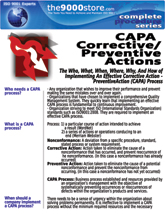The Great CAPA Balancing Act: Knowing How And When To Act
Many have written about companies that lack the resolve to fix a problem, even long after it is identified. But there are also reports of countless resources which are wasted by fixing problems that probably didn’t need fixing or justify the effort. Balancing these requires a blend of front end categorizations that help all employees known when action is needed, starting with these key questions:
- How often is the problem likely to occur? (Frequency)
- How important is it likely to be? (Importance)
- Has this issue been addressed before? (Re-Occurrence)
- Are we really being open minded? (Evaluate Options)
- Did we really solve the problem? (Verification)
We’ll look at each of these in more detail.
Frequency
It may be as difficult to predict the re-occurrence of a problem as the first occurrence of it. And yet, if there is at least an attempt to measure and scale this, a perspective can often be reached. This is particularly true if measurements exist that can compare that state of something. Poor inventory control can be a function of fluctuating customer demand, which may seem not to be controlled. But many vendors find ways to better predict a customer’s needs than they do. Starting with a simple scale of how frequently this issue is likely to occur can help determine the resources that need to be applied.
Free Download
For a limited time we’re giving our CAPA Process Guide away free. This is a time-tested outline for developing or improving your corrective action/preventative action approach (CAPA).
For instance, the guide helps you develop each phase of the process including:
- Record Potential or Actual Non-conformance
- Assign and Manage Request
- Investigate Root Cause
- Design Corrective Action
- Implement Corrective Action
- Follow-Up on Corrective Action to Assure Effectiveness
Importance
As far as importance, a higher level perspective can help decide the total impact of the problem. While not a guarantee, views from varying groups that are likely to be affected can help put the situation into perspective. The person(s) observing a potential or actual non-conformance initiates the process (often is called the “Requestor”) provides critical aid in this process in describing the problem. Having a CAPA administrator is also crucial to review and then request the appropriate people in the organization to assure the necessary action is taken in a timely manner.
Re-Occurrence
Maintaining a “lessons learned” database of some type can at least help with those problems that seemed to recur. Providing easy and ubiquitous access and encouraging/requiring appropriate logs are necessary actions for making this database useful in the CAPA process.
Evaluate Options
And yet, there are times when new people, technologies, production and market conditions conspire to hide solutions. In this case, a more open and interrogative style of inquiry is often needed. Being good investigators with the proper methods can lead more quickly to results in these situations than past experience with its preconceived notions (that may not have detected or fixed the problem in the first place)
Verification
And finally, verifying what actions were taken and what effects they had will help ensure that the problem won’t repeat (if it had – for instance- temporarily righted itself). Many times people think they have done what was asked/required only to move on a bit too quickly to the next issue without fully/correctly completing the needed actions.
In summary, no one can predict the future with 100% accuracy, and yet what CAPA teaches is that we can command our destiny to a great extent. Those who put effort into it are much less likely to repeat/experience unwanted past, or unpredictable future events.



